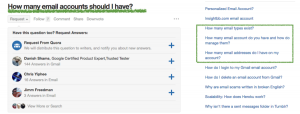
Content is and will remain the top priority for online marketing. Even if you run PPC or other ad campaigns, content marketing is the best way to get quality visits to your sites, and it can be done entirely for free.
Yet there is a great deal of variation in what marketers define as “quality content.” Some believe it can be defined by a magic formula of length, keyword density and subheaders. Some believe it has to do with how well you write and whether you use the right $ 10 words. What you really need to focus on is what is quality content from Google’s point of view — because it’s the search king that will ultimately bring visitors to your site or not.
Here are a few answers:
Write for Readers
So here’s where things get confusing right away: Google wants you to write for your readers, not for Google. But how do you turn your focus from Google when it is Google that you are trying to please to get the traffic you need to grow your business?
The answer is that you need to write content that offers real value to your readers, such as by answering a question they have or offering a solution to your problem, and you need to write it in a way that the average person would be able to easily read and enjoy. If you do that, you’ll be making your readers happy, which will make Google happy.
So before you strategize about keywords or any other tactics, you need to start by asking yourself what your readers want. Then you need to write content in the same way that you would give that information to a friend.
Be Honest
Marketers know that they have to write great headlines to encourage users to click through to their content. The trouble is that they often write headlines that are sort of related to the content but are actually very deceptive.
For example, a popular story has been advertised on social media that says something like, “You won’t believe the reason they canceled Melissa McCarthy’s contract on Mike & Molly!” When you click through to the article, it talks briefly about her weight loss and then goes on a hard-core sell for a gimmicky diet product. That’s incredibly dishonest. You need to deliver what you promise in your headline — and not just “sort of.”
If you claim to deliver a shocking solution, you better make sure that other people who read it will think it’s shocking. If you claim to offer something that no one else does, make sure no one else does. Don’t just repackage your claims or add inflammatory language to your content to make it seem better than it is. Readers will see through that, and so will Google.
Be Unique
Thousands of people may write an article on the same topic. How will yours stand out? Even the best quality writing will only gain a marginal edge, and that will mostly be to the shares it gets with the people who resonated with it. To truly stand out, you need to be unique.
If everyone is writing about why having a dog is good for your health, maybe you write about how only specific breeds are good for your health or how you’d be better off with a cat instead. If everyone is writing about how Trump will be a terrible president, you could write a post about how his history shows he’d actually be a liberal choice.
There are many ways that you can write about a topic and make it unique. Just make sure that whatever topic you choose isn’t opening up a can of worms you don’t want opened. For example, writing about Trump or any other presidential candidate could rain down controversy on your blog that you don’t actually want.
Avoid Tricks
One of the hardest things for marketers to avoid is over-optimization, or adding ridiculous amounts of keywords and tags to the page. However, over-optimization can actually hurt you, as can many more dubious tricks you may be tempted to try. Avoid using tactics like redirects, hidden keywords, link schemes, cloaking, hidden links, scraped or spun content, adding phishing software, and more. Again, it’s important that you remain honest. Create good content with good intentions, and Google will take notice.
Using tools like CodeFuel’s In-tag can also help you get more views on your content by recommending the right pages to the right visitors at the right time. The tool looks at user-generated signals to understand what your visitors will be most interested in seeing, and it automatically inserts those links. Using all of these tips together will help you get the visitors you need to start growing your site and your brand.
Digital & Social Articles on Business 2 Community(33)
Report Post







